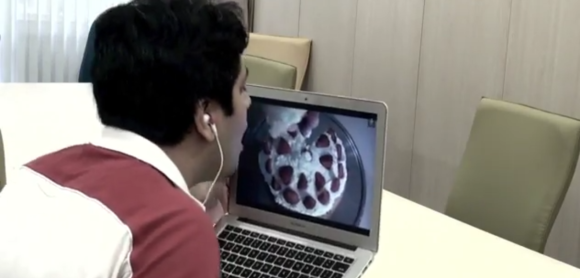
Not satisfied with late 1950s concepts of Smell-O-Vision [Nimesha] has created something extraordinary: A digital taste sensor, capable of representing taste with a little bit of heat, electricity, and an Arduino
The device purportedly works by via thermal and electrical stimulation of the tongue using silver electrodes. According to this video, different tastes are created with different currents and temperatures. For example, a sour taste is produced on the electrodes by varying the current from 60uA to 180uA and increasing the temperature up to 30 degrees C. Mint is produced by simply decreasing the temperature from 22C to 19C.
The control electronics include an Arduino, a motor controller, and a heat sink attached to one of the silver electrodes. Communication is done through USB, and of course there’s a mobile app for it, more specifically a protocol called Taste Over IP. This allows anyone to send a taste to anyone with one of these devices.
Videos below, and before you laugh, we’d really like to try one of these out.
Thanks [Jess] for the tip.
















Most of the taste buds and hence the sensation comes from the back of the tongue, so I really don’t see how it can work when they just touch the tip of their tongues…
They definitely need a Kickstarter for it ! :)
*nods* the “real” taste comes when you swallow.
That’s what she said.
+1000000 hahahahaaaaaa
+++ xD
Next up on Hackaday, DIY hinged jaw surgery…
3d printer project?
April 1st is still a month away.
I think this is really cool… in a creepy mad scientist kind of way of course.
Never accept a Taste over IP message from someone you don’t know and trust…
“Hey, I got a tst from Kyle… Mmf… DAMMIT he sent me his ass again!”
Rick-Rolled will becum pRick-Rolled ?
What happens if you eat some of the “miracle fruit” berry then stimulate a “sour” taste? Will it taste sweet, as-per the berry’s famed property?
Sadly, no. This bypasses the “chemo” part of the chemoreception involved in taste. The heat and electricity + any silver ions from the electrode may even hasten the miraculin denaturation.
However, should there be an electrochemical reaction between your saliva and/ or electrode that results in acidic compounds, THOSE might taste sweet.
Good choice of silver for the electrode as it’s got some antiseptic properties.
up next: a self-replicating taste sensor that generates electricity out of hot air?
This reminds me of the Google Nose prank (which was awesome).
The challenges behind a real taste interface would be huge. Electrical stimulation of the tongue ? Ok, so maybe you can use the tip of the tongue since all taste sensations come from all regions of the tongue. But how do you selectively stimulate tastebuds ? “Sweet when the current is inverted”, lol
Anyways, the tongue would only give you the five basic tastes. It won’t transmit flavor, since smell is the main determinant of a food item’s flavor, and olfaction is incredibly complex. We don’t even know how it works, but it seems to perform an in-depth analysis of every volatile molecule’s shape and features. So you would need to basically reconstruct every volatile molecule that makes the smell. mission f*cking impossible.
Hah, reminds me of the days before I could afford a multimeter… to test DC motors, I would lick 2 wires connected to the leads (there was no lead solder, I couldn’t afford that at age 7 either), and spin it. Years later, someone passed me what turned out to be a small 120v 60 RPM motor to test, I had no tools…
When I could speak again, I expressed my dissatisfaction quite colorfully. However I can confirm ~500v tastes like a mix of expired milk and infinite suffering, with a gentle aroma of embarrassing stupidity.
Still preferable to American coffee though.
That’s easily the funniest thing I’ve read all month! What a great story! And yes, we have crappy coffee over here…
once we create Replicators, like from star trek, we can just have a little spray that shoots up your nose, and of course, there’s no reason to actually SEND the food to them, no, only the taste.
God help us all if the adult film industry ever gets hold of this.
It will revolutionize internet pornography!
Another awful video.
The snozzberries taste like snozzberries
Violet is turning violet !
You know those videos where it has some nice or detailed images to get you to look closer and closer or soft sound to get you to turn up the volume and then *BOOM* boogeyman/girl/corpse or whatever with a scream? Okay, now imagine that with taste-o-vision.. Just a slight taste of apple pie.. turn up the ‘volume’ turn it up.. yeah there you go mmm yummmy…. *BOOM* CESSPOOL! I imagine this is pretty much how well this would go over on the Internet.
it tastes like burning
Is he dating Terezi Pyrope or just trying to impress her. Oh wait, she doesn’t need this anymore…